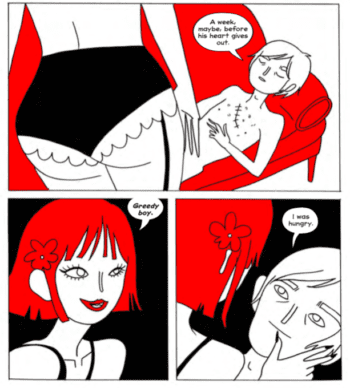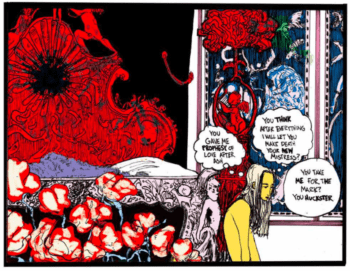Twisted Romance is a new four-issue anthology series from Image, with issues coming out every week this past February. Each issue consists of a main comics story that pairs writer Alex de Campi with a different artist, a backup comics story, and a prose story.
What if a noir detective story were also a supernatural romance about revenge, regret, and self-control, and it also took place in a discotheque in 1978? "Old Flames", which sees de Campi teamed up with Katie Skelly, is here to answer this hypothetical for you. It’s even more delightful than that summary sounds.
Our protagonist is Misha, the owner of a business called Heartbreak Incorporated, which specializes in breaking up romances. Into his tasteful, modern-art decorated office walks Sherri, a beautiful dame in a trenchcoat and sunglasses. Her husband Ian, a wealthy nightclub owner, is cheating on her, and she’s angry. She’s worried Ian is going to change his will and leave everything to his young paramour. Unlike in the private eye stories we’re used to, though, Sherri’s not asking Misha to get proof she can take to her lawyer: she wants the couple split up, permanently. By any means. Misha dresses in his finest disco wear and heads to the club, only to find that Ian’s lover is a someone from his past--someone not quite human.
How do we satisfy our desires without destroying other people? We all have things we need and things we want, but where do we draw the line? If my satisfaction can only come directly from your dissatisfaction, how do we resolve that? And how do we live with the choices we’ve made, the compromises we’ve reached to stay alive?
 These are big questions, but "Old Flames" doesn’t feel at all heavy to read. Katie Skelly’s art is, in a word, fun. The linework is both playful and confident, paired with bright, poppy colors. The flashback sequence is colored black/white/red, which sets it apart visually and underscores the theme of regret. The choices we made in the past are set in stone, the paths clear, the right answers more obvious. The details of our memories have been worn away with use. At the climax of the story, the panels flood with red as the action turns violent. Skelly’s deft touch with scene-setting is also at work in the sparing use of song lyrics, lettered outside the panel borders, as we enter the club. On another page, our only indication that Sherri is crying is that her mascara, intact in one panel, is running down her face in a later panel. The use of question marks at the end of declarative sentences to indicate uptalk is a genius way to underline the emotional tone of a scene. These techniques subtly guide you through the story, accumulating details without making them overt and distracting. The result is a fully-realized world with fleshed-out characters, no small feat for a story of thirty pages.
These are big questions, but "Old Flames" doesn’t feel at all heavy to read. Katie Skelly’s art is, in a word, fun. The linework is both playful and confident, paired with bright, poppy colors. The flashback sequence is colored black/white/red, which sets it apart visually and underscores the theme of regret. The choices we made in the past are set in stone, the paths clear, the right answers more obvious. The details of our memories have been worn away with use. At the climax of the story, the panels flood with red as the action turns violent. Skelly’s deft touch with scene-setting is also at work in the sparing use of song lyrics, lettered outside the panel borders, as we enter the club. On another page, our only indication that Sherri is crying is that her mascara, intact in one panel, is running down her face in a later panel. The use of question marks at the end of declarative sentences to indicate uptalk is a genius way to underline the emotional tone of a scene. These techniques subtly guide you through the story, accumulating details without making them overt and distracting. The result is a fully-realized world with fleshed-out characters, no small feat for a story of thirty pages.
The prose portion of Twisted Romance is by Magen Cubed. A supernatural mystery romance titled “Leather & Lace,” it features an uneasy accord between humans and vampires, with the occasional wendigo disturbing the peace. Half-eaten human corpses are turning up in the woods, and we can’t have that. Our vampire protagonist, Dorian Villeneuve (Vampire Name Hall of Fame candidate right there) and his human roommate, Cash Leroy, are tasked with finding the wendigos and taking them down. The county pays them for their service, seemingly with cash under the table, for bringing in wendigo corpses. It’s just a matter of finding them, and that’s where the mystery comes in. Oh, and Dorian is in love with Cash, hopelessly and completely.
The logic of this world can be a little opaque at first. Vampires traffic humans and take their blood, but don’t kill them. Cash Leroy is a “hunter” who brings down monsters who step out of line and murder humans, it seems. So is Dorian’s usual role to help him kill other vampires? As with all fantastical settings, I don’t need to know every detail, but I need to believe that the author has it all worked out. I need to see evidence of the internal logic cohering. I do believe Cubed has it all worked out, but the story isn’t holding my hand enough to keep me from being distracted with questions. I wondered if this were a story from a larger universe I’m not familiar with, almost like it was fan fiction for a universe I’ve never encountered before.
A good detective story has to be at least a little smarter than its reader. It’s a small thing, but I need to have confidence that these characters know what they’re doing. It must be tricky, leaving the audience enough clues that the solution doesn’t feel out of place while not giving the answers away. I’m not sure this story quite reaches that balance, but I believe it was within its grasp. Similarly, the story plays coy with whether or not Cash is gay: he is, and that’s not a secret from any of the characters, but I had to piece it together and was thrown off the scent by a joke about pronoun switches in karaoke performances. I often think about one of my poetry professors railing about “the ORDER in which inforMATion is preSENTed to the READER” and really, that’s this story’s only flaw: not quite enough consideration paid to the order information is released. Again, it’s minor, but if I’m distracted and going back to re-read passages because I’m sure I missed some detail, I’m not as absorbed in the story as I could be.
Still, there’s a lot to like here: a goth vampire boy donning his sunglasses and black parasol to interview small-town folks about wendigo murders is extremely charming. A vampire and a hunter falling in love and going to karaoke bars in the American south, where being gay can be as dangerous as being a monster? I’m so here for that. They even have a Chihuahua named Dominique!
 Sarah Horrock’s "Red Medusa on the Road to Hell" serves as the first issue’s closer—and it’s short and powerful. From the first panel of scratchy white hand-lettering on a black background, you can feel a howling desperation. The story is more impressionist than narrative; my read on it is a heartbroken woman, Alita, follows her dead lover into the underworld, where she’s reunited with a past flame.
Sarah Horrock’s "Red Medusa on the Road to Hell" serves as the first issue’s closer—and it’s short and powerful. From the first panel of scratchy white hand-lettering on a black background, you can feel a howling desperation. The story is more impressionist than narrative; my read on it is a heartbroken woman, Alita, follows her dead lover into the underworld, where she’s reunited with a past flame.
Horrocks’ art is visceral and chaotic, with scribbly bright lines against black backgrounds. The spidery, scratchy lettering lends immediacy to the pain expressed. Alita is angry, and her anger literally transforms her. From one close-up to the next, her face takes on new shapes, new colors, blown-out oversized zipatone shading her screaming skull. This feels like an excerpt from a larger story, and not in a bad way--these characters feel lived in, with large, complicated backstories that are evident but not necessary in the present story. Alita’s pain doesn’t feel resolved at the end, merely turned down temporarily, the way you can feel a migraine headache recede while still hovering at the edges of your senses.
In Twisted Romance #1, our characters are angry, spiteful, overcome with regret, extremely afraid, and always horny. As the kids say: Big Mood.







